Effects of Northern Hemisphere Atmospheric Blocking on Arctic Sea Ice Decline in Winter at Weekly Time Scales
Abstract
:1. Introduction
2. Data and Methodology
3. Key Regions of Arctic Sea Ice and Corresponding Atmospheric Patterns
3.1. Arctic Sea Ice Decline and Its Mixed Atmospheric Patterns
3.2. Four Key Regions for Arctic Sea Ice and Corresponding Blocking Patterns
4. The Northern Hemisphere Blocking Frequency and Its Link with SIC
5. Composite of the Blocking Events and Its Impacts on SIC
5.1. Composite of Regional Blocking Patterns and Sea Ice Decline at Weekly Time Scales
5.2. Composite of Variables Associated with Blocking
5.3. The Lead-Lag Relationship between Blocking and Sea Ice Decline
5.4. The Quantitative Estimation of the Sea Ice Decline and Radiation Variations Associated with the Blocking
6. Results and Discussion
Author Contributions
Funding
Acknowledgments
Conflicts of Interest
References
- Serreze, M.C.; Barry, R.G. Processes and impacts of Arctic amplification: A research synthesis. Glob. Planet. Chang. 2011, 77, 85–96. [Google Scholar] [CrossRef]
- Lesins, G.; Duck, T.J.; Drummond, J.R. Surface energy balance framework for arctic amplification of climate change. J. Clim. 2012, 25, 8277–8288. [Google Scholar] [CrossRef]
- Cohen, J.; Screen, J.A.; Furtado, J.C.; Barlow, M.; Whittleston, D.; Coumou, D.; Francis, J.; Dethloff, K.; Entekhabi, D.; Overland, J.; et al. Recent Arctic amplification and extreme mid-latitude weather. Nat. Geosci. 2014, 7, 627–637. [Google Scholar] [CrossRef] [Green Version]
- Ghatak, D.; Miller, J. Implications for Arctic amplification of changes in the strength of the water vapor feedback. J. Geophys. Res. Atmos. 2013, 118, 7569–7578. [Google Scholar] [CrossRef] [Green Version]
- Simmons, A.J.; Poli, P. Arctic warming in ERA-Interim and other analyses. Q. J. R. Meteorol. Soc. 2015, 141, 1147–1162. [Google Scholar] [CrossRef]
- Francis, J.A.; Hunter, E. New insight into the disappearing Arctic sea ice. EOS Trans. Am. Geophys. Union 2006, 87, 509–511. [Google Scholar] [CrossRef]
- Overland, J.E.; Wang, M. Large-scale atmospheric circulation changes are associated with the recent loss of Arctic sea ice. Tellus A 2010, 62, 1–9. [Google Scholar] [CrossRef] [Green Version]
- Gong, T.; Luo, D. Ural blocking as an amplifier of the Arctic sea ice decline in winter. J. Clim. 2017, 30, 2639–2654. [Google Scholar] [CrossRef]
- Francis, J.A.; Vavrus, S.J.; Cohen, J. Amplified arctic warming and mid-latitude weather: New perspectives on emerging connections. Wire. Clim. Chang. 2017, 8, e474. [Google Scholar] [CrossRef]
- Francis, J.A. Why are arctic linkages to extreme weather still up in the air? Bull. Am. Meteorol. Soc. 2017, 98, 2551–2557. [Google Scholar] [CrossRef]
- Screen, J.A.; Deser, C.; Smith, D.M.; Zhang, X.; Blackport, R.; Kushner, P.J.; Oudar, T.; McCusker, K.E.; Sun, L. Consistency and discrepancy in the atmospheric response to arctic sea-ice loss across climate models. Nat. Geosci. 2018, 11, 155–163. [Google Scholar] [CrossRef]
- Park, D.-S.R.; Lee, S.; Feldstein, S.B. Attribution of the recent winter sea ice decline over the Atlantic sector of the Arctic Ocean. J. Clim. 2015, 28, 4027–4033. [Google Scholar] [CrossRef]
- Luo, B.; Dehai, L.; Lixin, W.; Linhao, Z.; Ian, S. Atmospheric circulation patterns which promote winter Arctic sea ice decline. Environ. Res. Lett. 2017, 12, 054017. [Google Scholar] [CrossRef] [Green Version]
- Zhong, L.; Hua, L.; Luo, D. Local and external moisture sources for the Arctic warming over the Barents–Kara seas. J. Clim. 2018, 31, 1963–1982. [Google Scholar] [CrossRef]
- Lien, V.S.; Schlichtholz, P.; Skagseth, Ø.; Vikebø, F.B. Wind-driven Atlantic water flow as a direct mode for reduced Barents Sea ice cover. J. Clim. 2017, 30, 803–812. [Google Scholar] [CrossRef]
- Saenko, O.A.; Schmittner, A.; Weaver, A.J. On the role of wind-driven sea ice motion on ocean ventilation. J. Phys. Oceanogr. 2002, 32, 3376–3395. [Google Scholar] [CrossRef]
- Screen, J.A.; Simmonds, I. Increasing fall-winter energy loss from the Arctic Ocean and its role in Arctic temperature amplification. Geophys. Res. Lett. 2010, 37, L16707. [Google Scholar] [CrossRef]
- Luo, D.; Xiao, Y.; Yao, Y.; Dai, A.; Simmonds, I.; Franzke, C.L.E. Impact of Ural blocking on winter warm Arctic–cold Eurasian anomalies. Part I: Blocking-induced amplification. J. Clim. 2016, 29, 3925–3947. [Google Scholar] [CrossRef]
- Overland, J.; Francis, J.A.; Hall, R.; Hanna, E.; Kim, S.-J.; Vihma, T. The melting Arctic and midlatitude weather patterns: Are they connected? J. Clim. 2015, 28, 7917–7932. [Google Scholar] [CrossRef]
- Crasemann, B.; Handorf, D.; Jaiser, R.; Dethloff, K.; Nakamura, T.; Ukita, J.; Yamazaki, K. Can preferred atmospheric circulation patterns over the North-Atlantic-Eurasian region be associated with arctic sea ice loss? Polar Sci. 2017, 14, 9–20. [Google Scholar] [CrossRef]
- Yao, Y.; Luo, D.; Dai, A.; Simmonds, I. Increased quasi stationarity and persistence of winter Ural blocking and Eurasian extreme cold events in response to Arctic warming. Part I: Insights from observational analyses. J. Clim. 2017, 30, 3549–3568. [Google Scholar] [CrossRef]
- Berggren, R.; Bolin, B.; Rossby, C.G. An aerological study of zonal motion, its perturbations and break-down. Tellus 1949, 1, 1–37. [Google Scholar] [CrossRef]
- Rex, D.F. Blocking action in the middle troposphere and its effect upon regional climate: I. An acrological study of blocking action. Tellus 1950, 2, 196–211. [Google Scholar]
- Dee, D.P.; Uppala, S.M.; Simmons, A.J.; Berrisford, P.; Poli, P.; Kobayashi, S.; Andrae, U. The ERA-Interim reanalysis: Configuration and performance of the data assimilation system. Q. J. R. Meteorol. Soc. 2011, 137, 553–597. [Google Scholar] [CrossRef]
- Yao, Y.; Luo, D.H. An asymmetric spatiotemporal connection between the Euro-Atlantic blocking within the NAO life cycle and European climates. Adv. Atmos. Sci. 2018, 35, 796–812. [Google Scholar] [CrossRef]
- Tibaldi, S.; Molteni, F. On the operational predictability of blocking. Tellus 1990, 42A, 343–365. [Google Scholar] [CrossRef]
- Luo, D.; Yao, Y.; Dai, A.; Simmonds, I.; Zhong, L. Increased quasi stationarity and persistence of winter Ural blocking and Eurasian extreme cold events in response to Arctic warming. Part II: A theoretical explanation. J. Clim. 2017, 30, 3569–3587. [Google Scholar] [CrossRef]
- Honda, M.; Inoue, J.; Yamane, S. Influence of low Arctic sea-ice minima on anomalously cold Eurasian winters. Geophys. Res. Lett. 2009, 36, 262–275. [Google Scholar] [CrossRef]
- Alexander, L.V.; Zhang, X.; Peterson, T.C.; Caesar, J.; Gleason, B.; Tank, A.M.G.K.; Haylock, M.; Collins, D.; Trewin, B.; Rahimzadeh, F.; et al. Global observed changes in daily climate extremes of temperature and precipitation. J. Geophys. Res. Atmos. 2006, 111, D05109. [Google Scholar] [CrossRef]
- Kwok, R. Recent changes in Arctic Ocean sea ice motion associated with the North Atlantic oscillation. Geophys. Res. Lett. 2000, 27, 775–778. [Google Scholar] [CrossRef]
- Rigor, I.G.; Wallace, J.M.; Colony, R.L. Response of sea ice to the Arctic oscillation. J. Clim. 2002, 15, 2648–2663. [Google Scholar] [CrossRef]
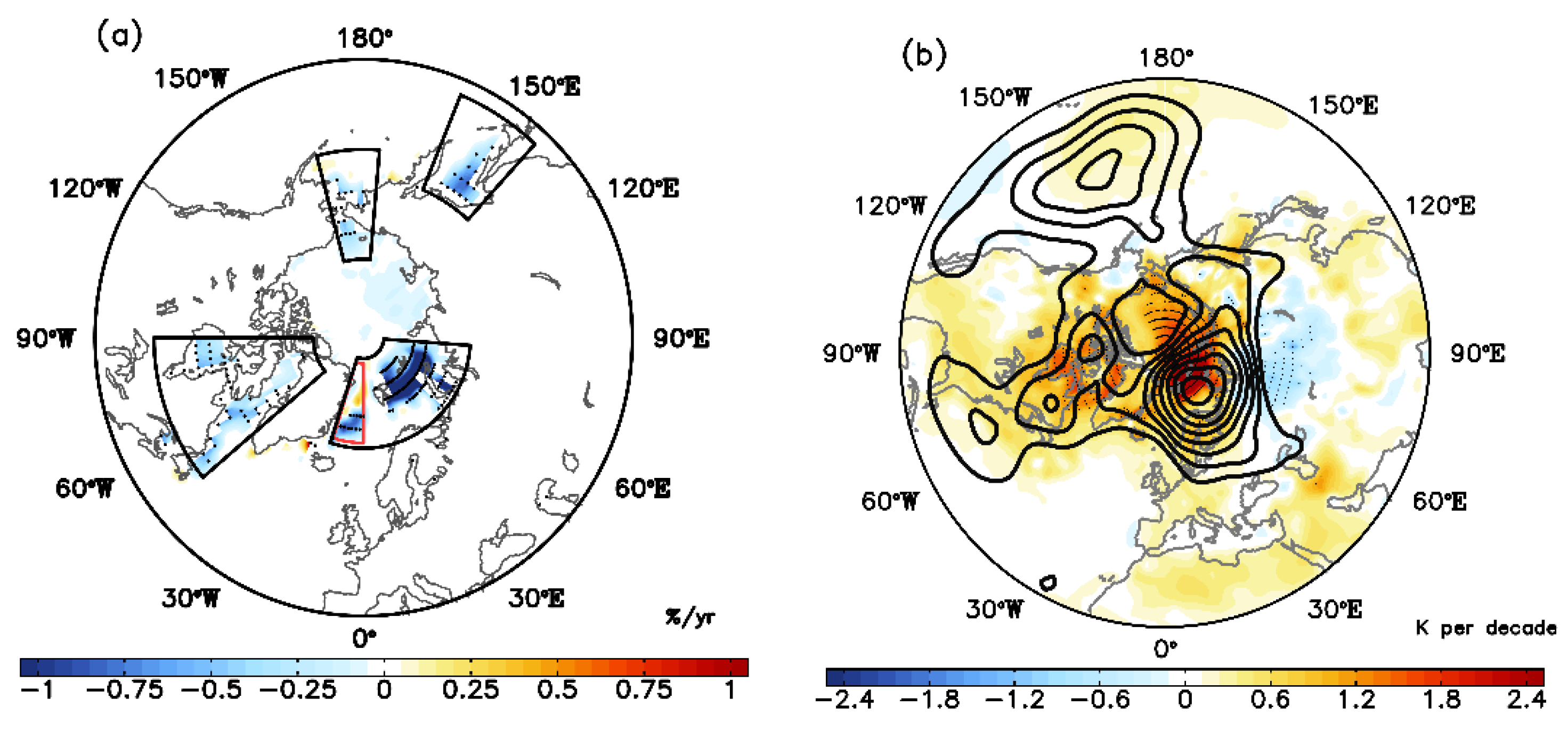

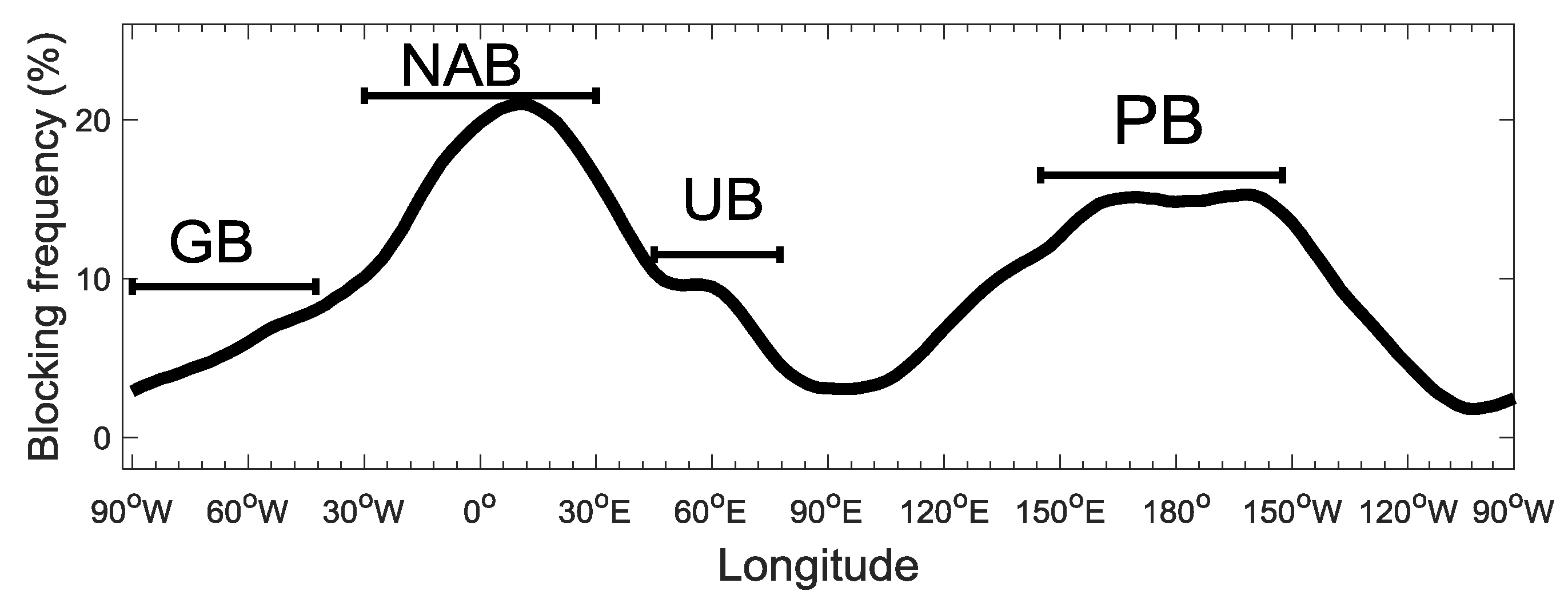
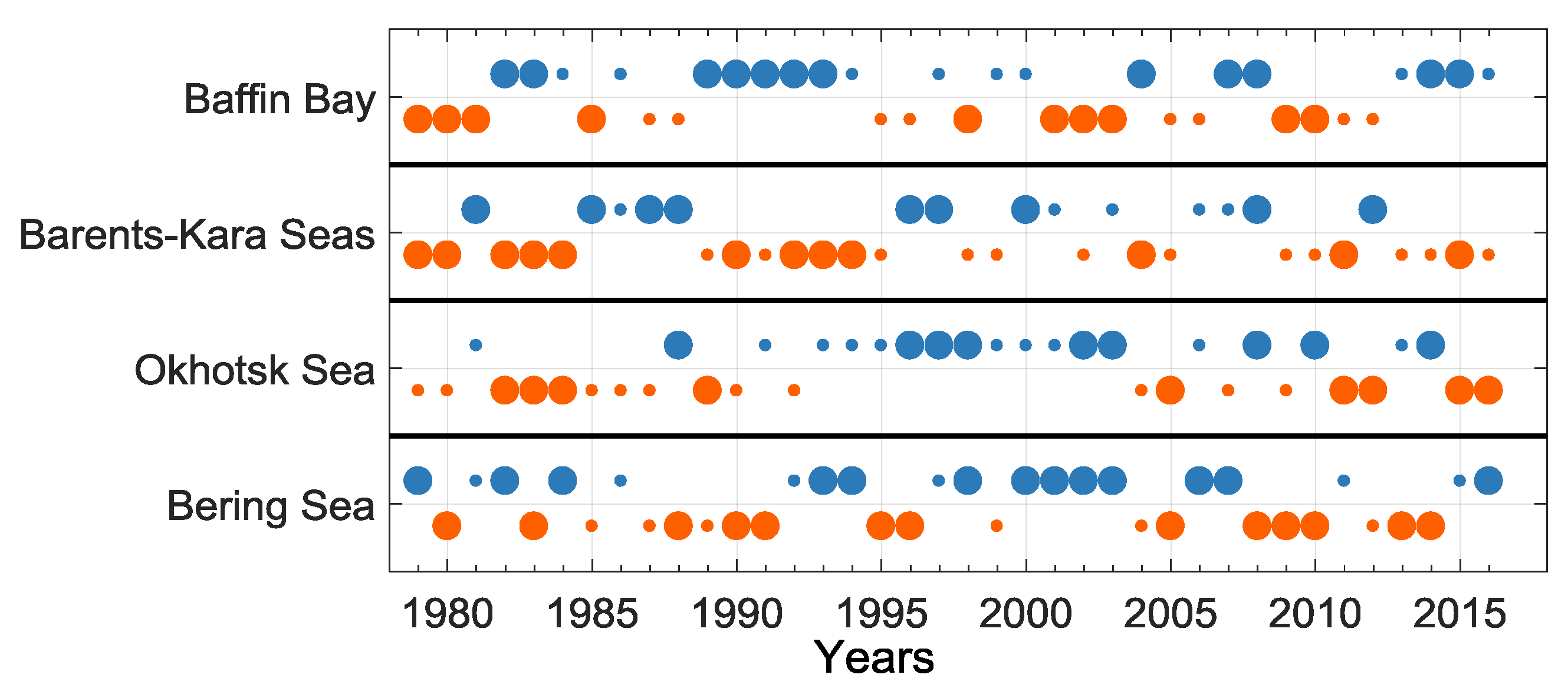

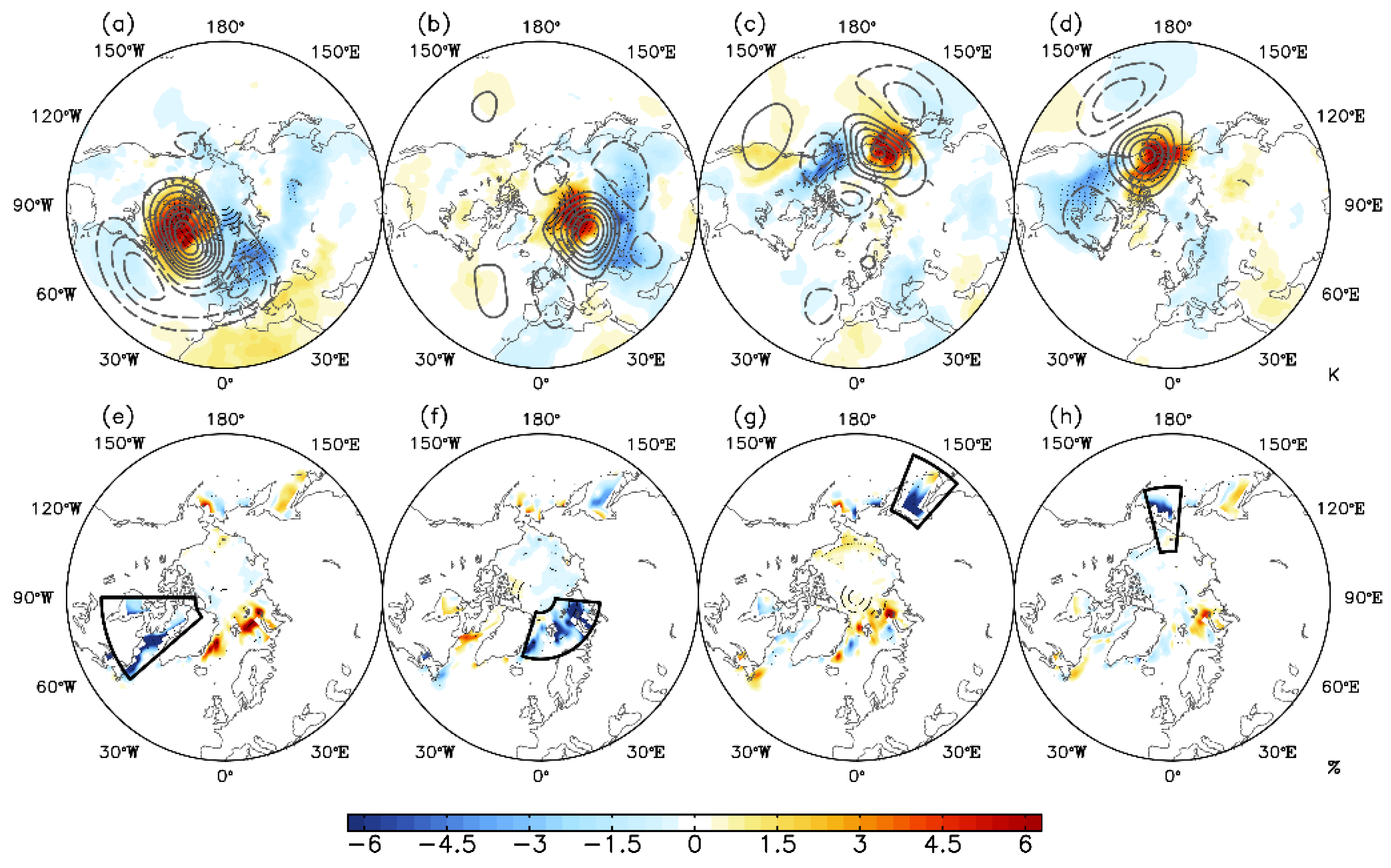
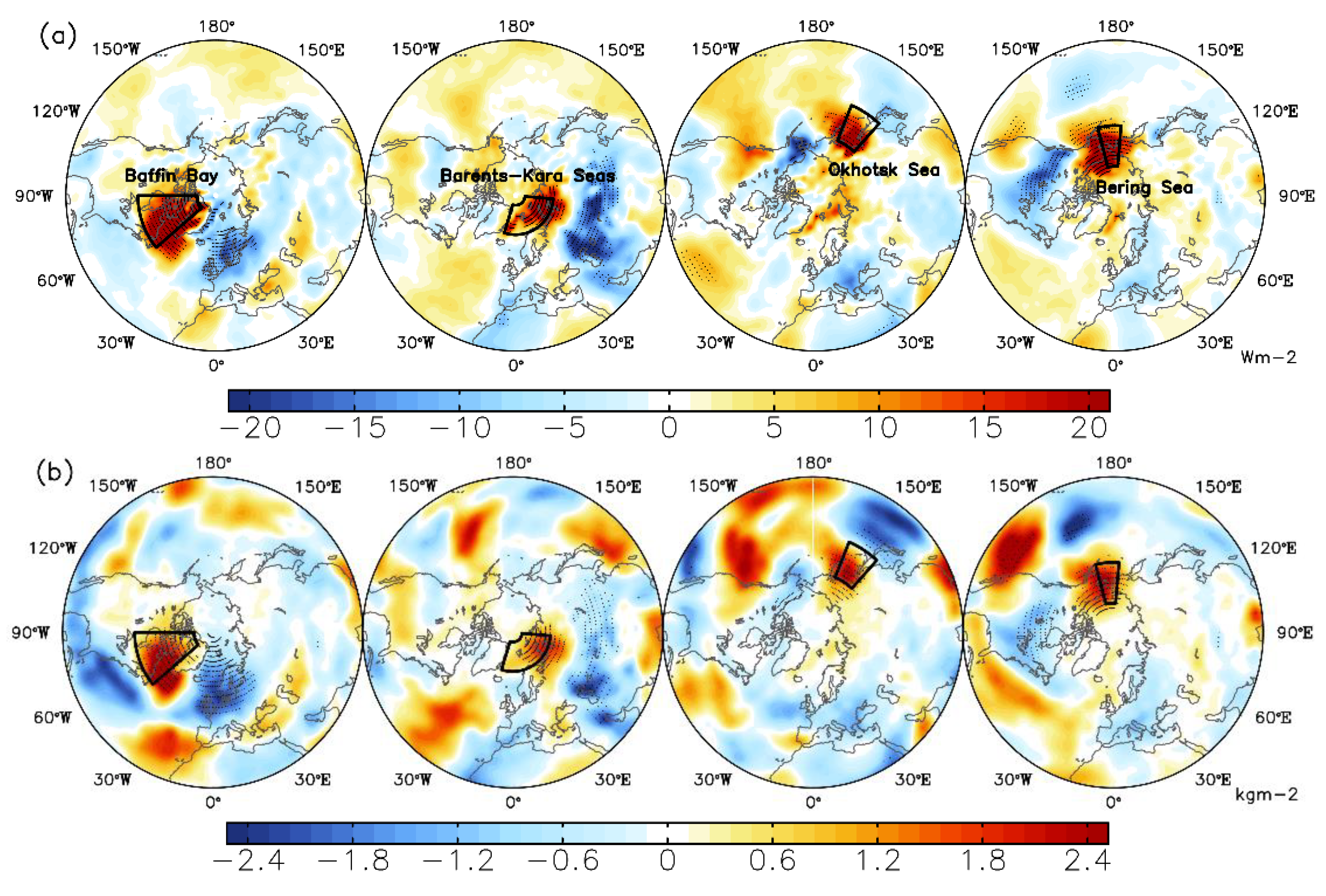
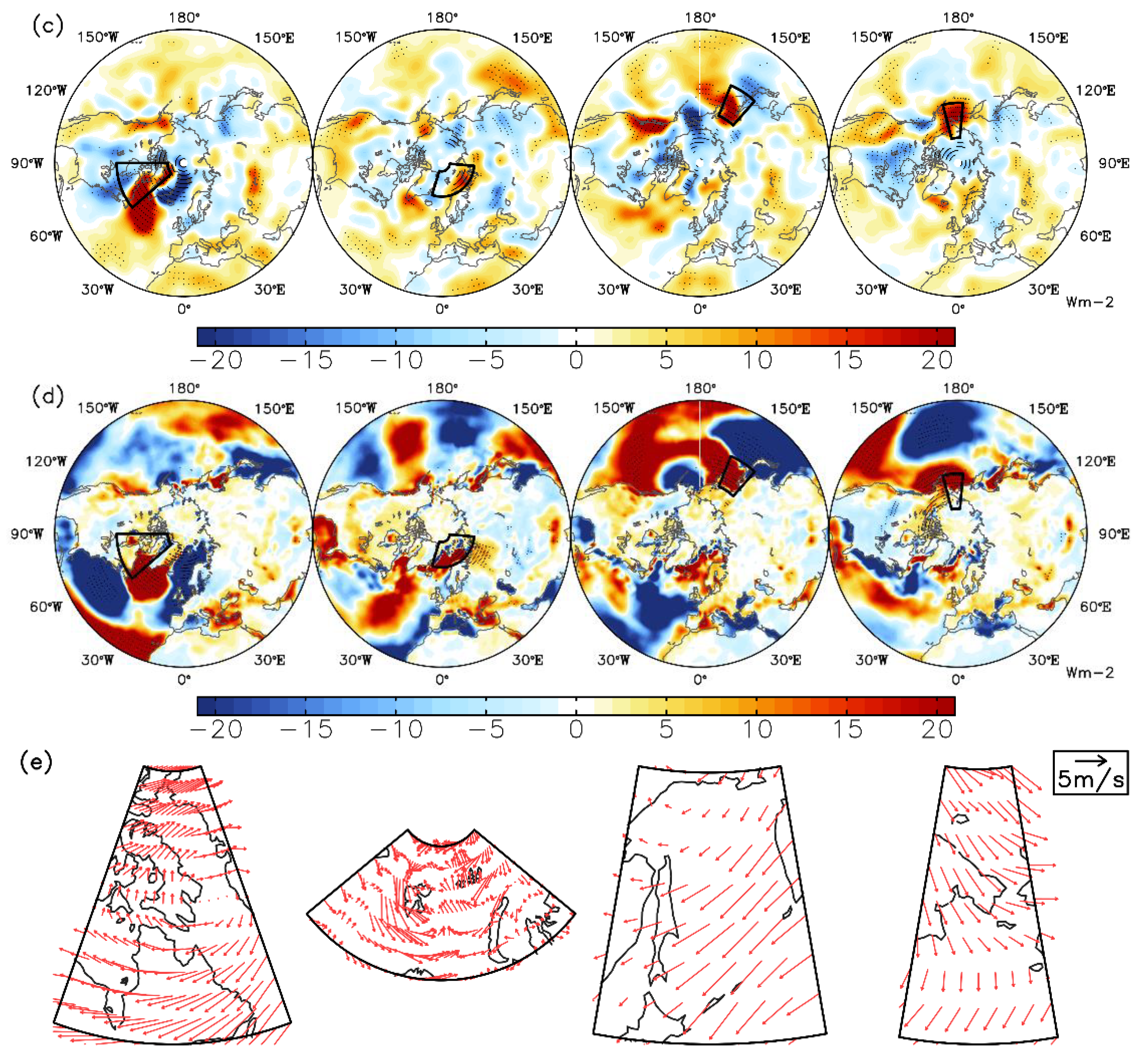
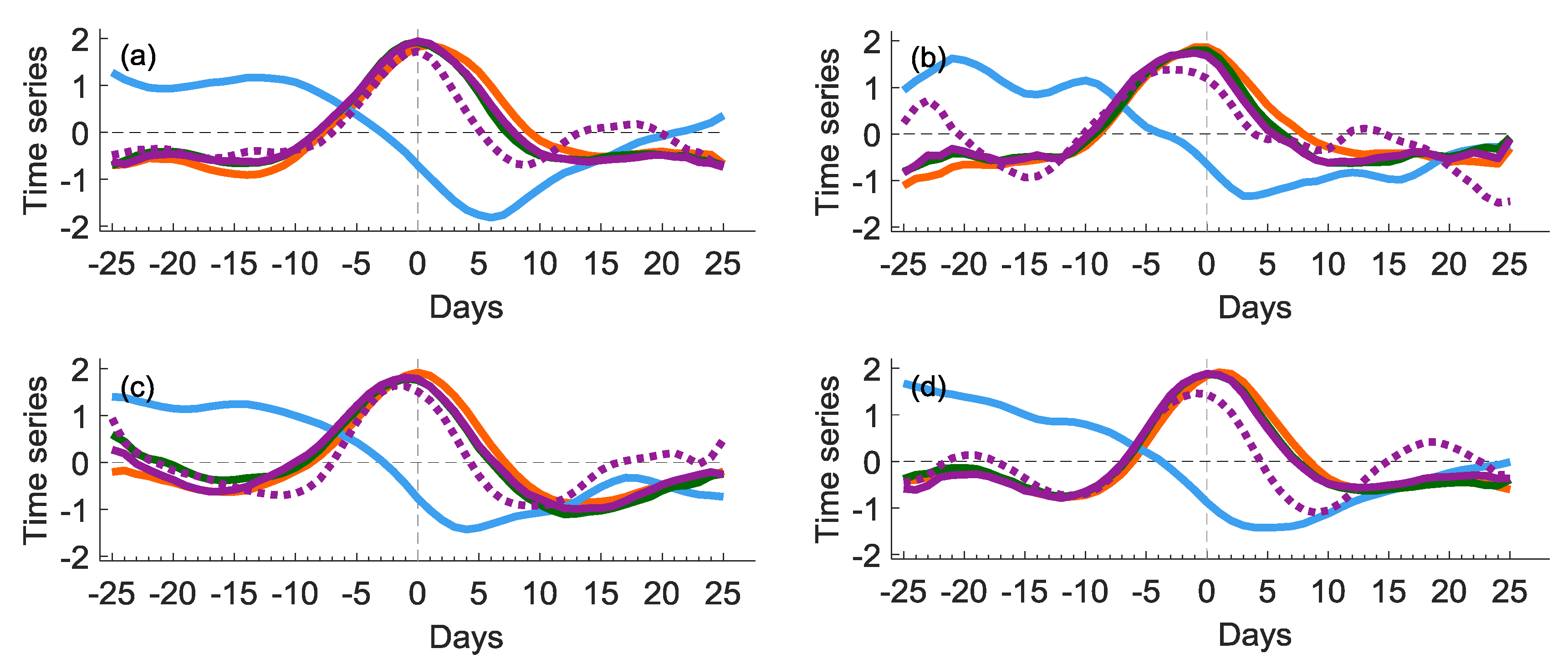
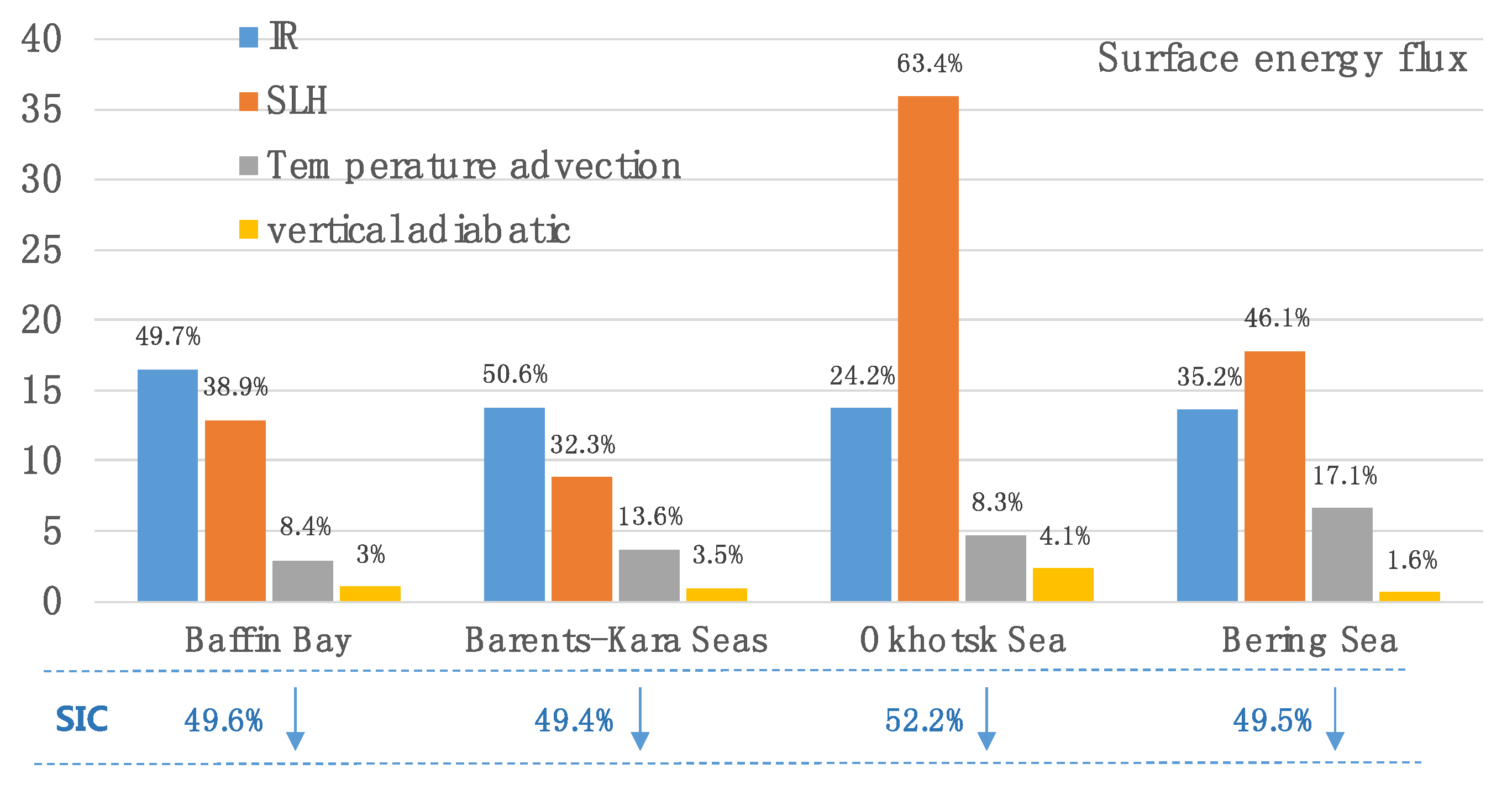
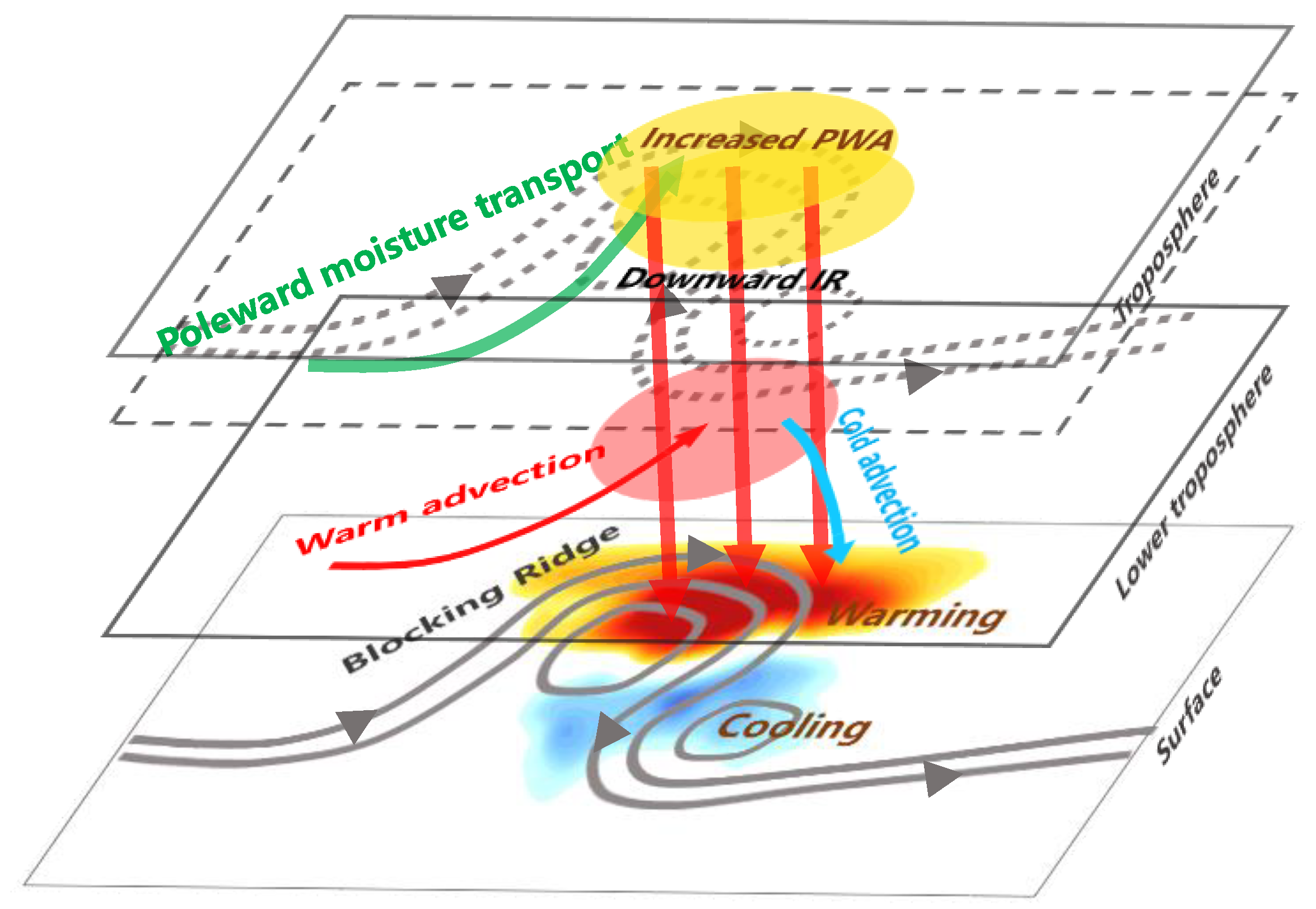
| Region | Blocking | Event Number | Total Days | Duration | Strength |
|---|---|---|---|---|---|
| Greenland | GB | 55 | 252 | 4.6 | 8.6 |
| Ural Mountains | UB | 56 | 278 | 5 | 4.2 |
| Western Pacific | PB-W | 43 | 167 | 3.9 | 9.6 |
| Eastern Pacific | PB-E | 90 | 419 | 4.7 | 6.8 |
© 2018 by the authors. Licensee MDPI, Basel, Switzerland. This article is an open access article distributed under the terms and conditions of the Creative Commons Attribution (CC BY) license (http://creativecommons.org/licenses/by/4.0/).
Share and Cite
Yao, Y.; Luo, D.; Zhong, L. Effects of Northern Hemisphere Atmospheric Blocking on Arctic Sea Ice Decline in Winter at Weekly Time Scales. Atmosphere 2018, 9, 331. https://doi.org/10.3390/atmos9090331
Yao Y, Luo D, Zhong L. Effects of Northern Hemisphere Atmospheric Blocking on Arctic Sea Ice Decline in Winter at Weekly Time Scales. Atmosphere. 2018; 9(9):331. https://doi.org/10.3390/atmos9090331
Chicago/Turabian StyleYao, Yao, Dehai Luo, and Linhao Zhong. 2018. "Effects of Northern Hemisphere Atmospheric Blocking on Arctic Sea Ice Decline in Winter at Weekly Time Scales" Atmosphere 9, no. 9: 331. https://doi.org/10.3390/atmos9090331
APA StyleYao, Y., Luo, D., & Zhong, L. (2018). Effects of Northern Hemisphere Atmospheric Blocking on Arctic Sea Ice Decline in Winter at Weekly Time Scales. Atmosphere, 9(9), 331. https://doi.org/10.3390/atmos9090331






